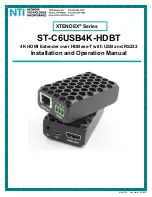
NTI 4K HDMI EXTENDER OVER HDBASE-T
7
TROUBLESHOOTING
Display has a black screen
Make sure power is connected (blue LED is ON)
Make sure all cables are firmly connected at the transmitter, receiver, and the
devices
Make sure video source and display are powered ON and fully booted
Power cycle the Transmitter and Receiver after cable connections have been
checked
Screen is distorted or displays noise
Check to make sure resolution is within the specified limitations
Power cycle the entire system
Power down, disconnect and reconnect all cables, and power back ON.
TECHNICAL SPECIFICATIONS
Transmitter
Compatibility
USB computer (PC, SUN and MAC) with Ultra-HD HDMI output
Windows 2000/XP/Vista/7/8/10, Windows Server 2000/2003/2008/2012, Solaris, Linux, FreeBSD,
and MAC OS 9/10.
Connectors
One female HDMI connector.
One female USB Type B Mini connector.
3-pin screw terminal for RS232.
One female RJ45 port for sending/receiving UHD video, audio, USB, RS232 and DDC signals.
Receiver
Connectors
One female HDMI connector for display.
One female USB Type Mini B connector for connecting USB keyboard, mouse, flash drive,
HDD, or touchscreen display.
o
Use a USB hub to extend multiple USB devices.
3-pin screw terminal for RS232.
o
Support full-duplex RS232 up to 115200 baud.
Resolutions supported
Ultra-HD 4Kx2K resolutions:
o
3840x2160 at 60Hz, 4:2:0
o
3840x2160 at 30Hz, 4:4:4
2K Cinema (2048x1080 at 60Hz)
HDTV resolutions to 1080p
Up to 1920x1200 (WUXGA)
Audio Support
Supports embedded digital audio through HDMI compatible TVs or audio receivers.
General
Dimensions (WxDxH) (In.)
1.73x2.87x0.98 (44x73x25mm)
Power (Local and Remote)
100 to 240 VAC at 50 or 60 Hz; 5VDC,2A via AC adapter. (2x US AC adapter included.)
Operating temperature
32 to 122°F (0 to 50°C).
Storage temperature
-4 to 167°F (-20 to 75°C).
Operating/storage relative
humidity
5 to 95% non-condensing RH
Maximum distance
328 feet (100 meters)
Cable type
CAT6/6a/7 cable
Regulatory Approvals
CE, FCC, RoHS, TAA compliant
Note: When routing the CATx cable, be careful not to loop the wire. Loops in the cable tend to cause signal
degradation.





























